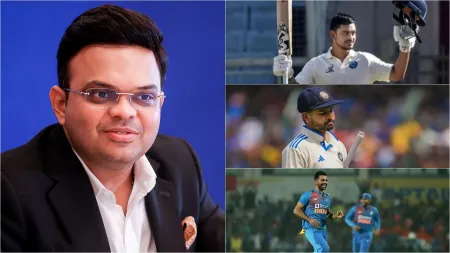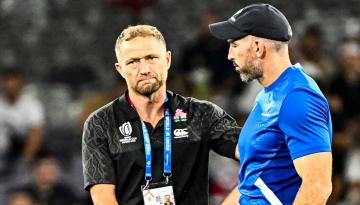How Indian cricket got its transition wrong? Top 6 at Rajkot with just 85 Tests between them
Rohit Sharma, Yashasvi Jaiswal, Shubman Gill, Rajat Patidar, Sarfaraz Khan, Dhruv Jurel. Memory fails to recall the last time an Indian Test team so light on batting experience took the field. Sure, Virat Kohli was unavailable, KL Rahul injured but still how can a nation known for consistently producing world-class batting masters have a top half with a combined experience of just 85 Tests between them.
There’s something wrong, somewhere. How did India’s Test transition go horribly wrong? This could be a valid explanation. While India has been in a tearing hurry to give up on their aging stars in red-ball cricket; in T20 cricket, the most frivolous of formats, they conveniently shift the goal post.

Veterans Virat Kohli and Rohit Sharma – easily not among the highest run-getters in IPL for a while now – were insisted on even for the innocuous series against T20 Afghanistan and are likely to be on the billboards for the World T20 is US later this year.
The mindset of the same group of selectors and team management seems to change when they sit to pick the Test team. For those in India whites, 35 seems to be the unwritten and unofficial age of retirement. One slip up and they have to make way for the young, and not all have been able to deal with the complexity of cricket’s toughest format. Shreyas Iyer, is the first name that comes to mind.
At Rajkot, with the series tied 1-1, India took a leap of faith. For potentially the decisive Test of the series, the home team trusted the untested youngsters and the runs they amassed on the domestic circuit that even India A and IPL players famously avoid these days.
India isn’t used to such statistical frugality or being seen as “weak on paper”. This batting order has seen better days. Turn back the clock to the Fab Four era, when the present coach Rahul Dravid was in his batting prime. That was when India’s batting line-up regularly had 3 to 4 batsmen with 100 plus Tests behind them.
The batting riches for Sourav Ganguly’s last Test in 2008 provides the mind-numbing contrast to thriftiness of top order at Rajkot. Virender Sehwag, Murali Vijay, Rahul Dravid, Sachin Tendulkar, Sourav Ganguly and VVS Laxman. Tendulkar finished with 200 Tests and Dravid was behind him with 164.
How times and priorities change. While most of the greats of the last generation played till the late 30s, of late, the selectors have been less patient with aging Test cricketers. Tendular was 40 when he retired; Dravid was 39, Laxman 38, Ganguly 36 and Sehwag 35.
For context, Dravid in 2008 was in the middle of a terrible slump. In 10 Tests, he had one 50. At that point India’s No.3 was grappling with thoughts of retiring from the game. After a series against Australia where he finished with an average of 14 from 4 Tests, Ricky Ponting told him to hang on. Years later, the Aussie captain would tell the world about it. “I found him at the end of the series and said ‘don’t you even think about retiring’ because I just saw some stuff in a few of his innings that suggested he was still a very, very good player,” Ponting told Dravid. He did. Who wouldn’t? He was 35 and there was no nudge from the selectors.
The rope given to the present day batsmen hasn’t been that long. Even if they had the rival captain tell them they needed to hang on, it wouldn’t have mattered. Wriddhiman Saha, Ajinkya Rahane, Hanuma Vihari and Cheteshwar Pujara – all conventional Test specialists – had the sword hanging on their heads as soon as they entered the 30s.
At a time when Shubman Gill kept being retained in the side despite his poor run, a cricketer from the previous generation, Anil Kumble, had said: “He (Gill) has been given the cushion perhaps even a Cheteshwar Pujara didn’t get, although he (Pujara) has played over a 100 Tests.”
Since Saha ended his career on a bitter note, complaining of him being misinformed by the then BCCI president Sourav Ganguly, India hasn’t had a wicket-keeper with Test quality. After Pujara, Rahane and Vihari; their spot hasn’t been sealed by their young replacements.
There happens to be a fundamental flaw in the way the team management has gone about taking these big decisions. The art of Test cricket needs nuance and Test cricketers are a dying breed in this day and age. In case they have proven longer-format players, they need to preserve them. Give them confidence, increase their longevity.
It is in T20, a format that needs full of energy big-hitter batsmen, that the decision-making can show their bravado, take chances, hedge their bets on batsmen that show a sliver of talent. And since IPL throws up T20 heroes every other game, the talent pool is bottomless. Be it wicket-keeping, middle order or captaincy, there are many worthy claimants to these crucial positions for the World T20 in the US. Come on, this is a half-day spin of a roulette where even a Joginder Sharma can win you the Cup.
Send your feedback to sandydwivedi@gmail.com
Disclaimer: The copyright of this article belongs to the original author. Reposting this article is solely for the purpose of information dissemination and does not constitute any investment advice. If there is any infringement, please contact us immediately. We will make corrections or deletions as necessary. Thank you.





